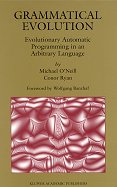Beginning with an overview of the necessary background material in Genetic Programming and Molecular Biology, Grammatical evolution: Evolutionary Automatic Programming in an Arbitrary Language outlines state of the art in grammatical and genotype-phenotype-based approaches. Following a description of Grammatical Evolution and its application to a number of example problems, an in-depth analysis of the approach is conducted, focusing on areas such as the degenerate genetic code, wrapping, and crossover. The book continues with a description of hot topics in Grammatical Evolution and presents possible directions for future research.
Grammatical Evolution is a new kind of evolutionary algorithm that evolves computer programs in an indirect manner. The evolved “genotype” is a string of numbers (in contrast to the explicit program code genotype of Genetic Programming, for example). These numbers are decoded into a program by using them to index into a BNF description of the program’s grammar, and using the indexed productions as the components of the generated program.
This book, written by GE’s inventors, explains the process. There is some biological background, a description of the GE algorithm itself, and some simple case-studies demonstrating its effectiveness. If you want a brief, clear overview of GE, and some background material, here it is.


